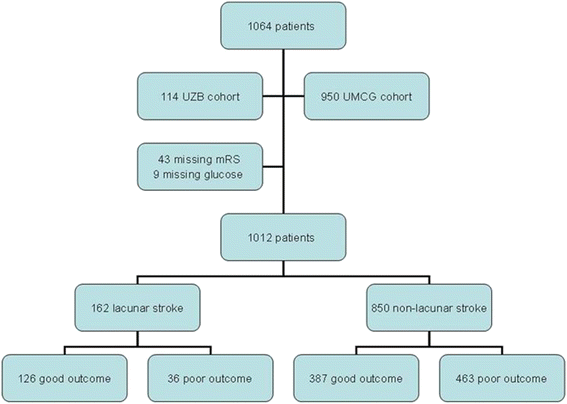Admission hyperglycemia and outcome after intravenous thrombolysis: is there a difference among the stroke-subtypes?
- PMID: 27422152
- PMCID: PMC4946238
- DOI: 10.1186/s12883-016-0617-0
Admission hyperglycemia and outcome after intravenous thrombolysis: is there a difference among the stroke-subtypes?
Abstract
Background: The prognostic influence of hyperglycemia in acute stroke has been well established. While in cortical stroke there is a strong association between hyperglycemia and poor outcome, this relation is less clear in lacunar stroke. It has been suggested that this discrepancy is present among patients treated with intravenous tissue plasminogen activator (tPA), but confirmation is needed.
Methods: In two prospectively collected cohorts of patient treated with intravenous tPA for acute ischemic stroke, we investigated the effect of hyperglycemia (serum glucose level >8 mmol/L) on functional outcome in lacunar and non-lacunar stroke. Poor functional outcome was defined as modified Rankin Scale score ≥ 3 at 3 months.
Results: A total of 1012 patients was included of which 162 patients (16%) had lacunar stroke. The prevalence of hyperglycemia did not differ between stroke subtypes (22% vs 21%, p = 0.85). In multivariate analysis hyperglycemia was associated with poor functional outcome in non-lacunar stroke (OR 2.1, 95% CI 1.39-3.28, p = 0.001). In patients with lacunar stroke, we did not find an association (OR 1.8, 95% CI 0.62-4.08, p = 0.43).
Conclusion: This study confirms a difference in prognostic influence of hyperglycemia between non-lacunar and lacunar ischemic stroke.
Keywords: Acute ischemic stroke; Functional outcome; Hyperglycemia; Stroke subtype; Tissue plasminogen activator.
Figures
Similar articles
-
The correlation between admission blood glucose and intravenous rt-PA-induced arterial recanalization in acute ischemic stroke: a multi-centre TCD study.Int J Stroke. 2015 Oct;10(7):1087-92. doi: 10.1111/ijs.12517. Epub 2015 Sep 1. Int J Stroke. 2015. PMID: 26332252 Clinical Trial.
-
Impact of admission hyperglycemia on stroke outcome after thrombolysis: risk stratification in relation to time to reperfusion.Stroke. 2004 Nov;35(11):2493-8. doi: 10.1161/01.STR.0000143728.45516.c6. Epub 2004 Oct 7. Stroke. 2004. PMID: 15472110
-
Hyperglycemia predicts unfavorable outcomes in acute ischemic stroke patients treated with intravenous thrombolysis among a Chinese population: A prospective cohort study.J Neurol Sci. 2018 May 15;388:195-202. doi: 10.1016/j.jns.2018.03.022. Epub 2018 Mar 16. J Neurol Sci. 2018. PMID: 29627022
-
The efficacy of thrombolysis in lacunar stroke - evidence from the Austrian Stroke Unit Registry.Eur J Neurol. 2017 Jun;24(6):780-787. doi: 10.1111/ene.13288. Epub 2017 Apr 27. Eur J Neurol. 2017. PMID: 28449276
-
Thrombolysis in acute stroke patients with cerebral small vessel disease.Cerebrovasc Dis. 2014;37(1):5-13. doi: 10.1159/000356796. Epub 2013 Dec 17. Cerebrovasc Dis. 2014. PMID: 24355873 Review.
Cited by
-
Association between hyperglycemia and unfavorable outcome in patients with successful thrombectomy for acute ischemic stroke: a single-center study.BMC Neurol. 2025 Aug 13;25(1):333. doi: 10.1186/s12883-025-04357-4. BMC Neurol. 2025. PMID: 40804609 Free PMC article.
-
Association of HbA1c with functional outcome by ischemic stroke subtypes and age.Front Neurol. 2023 Sep 28;14:1247693. doi: 10.3389/fneur.2023.1247693. eCollection 2023. Front Neurol. 2023. PMID: 37840925 Free PMC article.
-
Systematic Review of Existing Stroke Guidelines: Case for a Change.Biomed Res Int. 2022 Jun 15;2022:5514793. doi: 10.1155/2022/5514793. eCollection 2022. Biomed Res Int. 2022. PMID: 35722461 Free PMC article.
-
Coagulation markers and functional outcome in acute ischemic stroke: Impact of intensive versus standard hyperglycemia control.Res Pract Thromb Haemost. 2021 Jul 14;5(5):e12563. doi: 10.1002/rth2.12563. eCollection 2021 Jul. Res Pract Thromb Haemost. 2021. PMID: 34278192 Free PMC article.
-
The Prognostic Significance of Early Glycemic Profile in Acute Ischemic Stroke Depends on Stroke Subtype.J Clin Med. 2023 Feb 23;12(5):1794. doi: 10.3390/jcm12051794. J Clin Med. 2023. PMID: 36902581 Free PMC article.
References
-
- Ahmed N, Davalos A, Eriksson N, Ford GA, Glahn J, Hennerici M, et al. Association of admission blood glucose and outcome in patients treated with intravenous thrombolysis: results from the Safe Implementation of Treatments in Stroke International Stroke Thrombolysis Register (SITS-ISTR) Arch Neurol. 2010;67(9):1123–30. doi: 10.1001/archneurol.2010.210. - DOI - PubMed
Publication types
MeSH terms
Substances
LinkOut - more resources
Full Text Sources
Other Literature Sources
Medical


